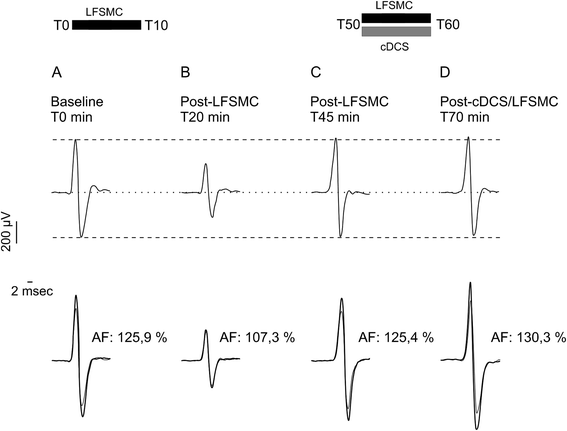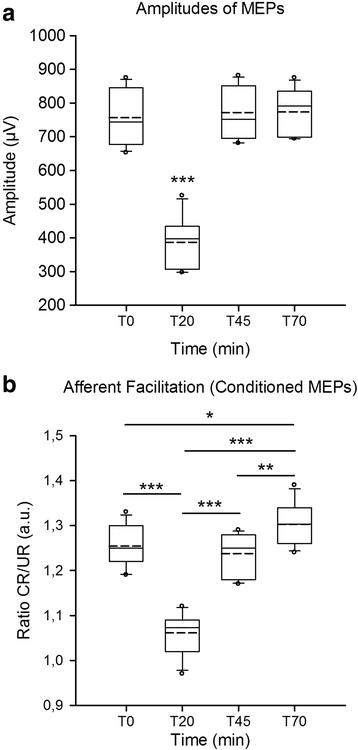The in vivo reduction of afferent facilitation induced by low frequency electrical stimulation of the motor cortex is antagonized by cathodal direct current stimulation of the cerebellum
- PMID: 27579172
- PMCID: PMC5004309
- DOI: 10.1186/s40673-016-0053-3
The in vivo reduction of afferent facilitation induced by low frequency electrical stimulation of the motor cortex is antagonized by cathodal direct current stimulation of the cerebellum
Abstract
Background: Low-frequency electrical stimulation to the motor cortex (LFSMC) depresses the excitability of motor circuits by long-term depression (LTD)-like effects. The interactions between LFSMC and cathodal direct current stimulation (cDCS) over the cerebellum are unknown.
Methods: We assessed the corticomotor responses and the afferent facilitation of corticomotor responses during a conditioning paradigm in anaesthetized rats. We applied LFSMC at a frequency of 1 Hz and a combination of LFSMC with cDCS.
Results: LFSMC significantly depressed both the corticomotor responses and the afferent facilitation of corticomotor responses. Simultaneous application of cDCS over the cerebellum antagonized the depression of corticomotor responses and cancelled the depression of the afferent facilitation.
Conclusion: Our results demonstrate that cDCS of the cerebellum is a potent modulator the inhibition of the motor circuits induced by LFSMC applied in vivo. These results expand our understanding of the effects of cerebellar DCS on motor commands and open novel applications for a cerebellar remote control of LFSMC-induced neuroplasticity. We suggest that the cerebellum acts as a neuronal machine supervising not only long-term potentiation (LTP)-like effects, but also LTD-like effects in the motor cortex, two mechanisms which underlie cerebello-cerebral interactions and the cerebellar control of remote plasticity. Implications for clinical ataxiology are discussed.
Keywords: Cerebellum; Direct current stimulation; In vivo; Motor cortex; Neuromodulation; Plasticity.
Figures


Similar articles
-
Effects of trains of high-frequency stimulation of the premotor/supplementary motor area on conditioned corticomotor responses in hemicerebellectomized rats.Exp Neurol. 2008 Jul;212(1):157-65. doi: 10.1016/j.expneurol.2008.03.016. Epub 2008 Mar 31. Exp Neurol. 2008. PMID: 18482725
-
Trains of epidural DC stimulation of the cerebellum tune corticomotor excitability.Neural Plast. 2013;2013:613197. doi: 10.1155/2013/613197. Epub 2013 May 20. Neural Plast. 2013. PMID: 23766921 Free PMC article.
-
Drug-Responsive Inhomogeneous Cortical Modulation by Direct Current Stimulation.Ann Neurol. 2020 Sep;88(3):489-502. doi: 10.1002/ana.25822. Epub 2020 Jul 25. Ann Neurol. 2020. PMID: 32542794 Free PMC article.
-
Transcranial cerebellar direct current stimulation (tcDCS): motor control, cognition, learning and emotions.Neuroimage. 2014 Jan 15;85 Pt 3:918-23. doi: 10.1016/j.neuroimage.2013.04.122. Epub 2013 May 9. Neuroimage. 2014. PMID: 23664951 Review.
-
Modulation of motor cortex excitability by sustained peripheral stimulation: the interaction between the motor cortex and the cerebellum.Cerebellum. 2005;4(2):90-6. doi: 10.1080/14734220410019084. Cerebellum. 2005. PMID: 16035190 Review.
Cited by
-
Effects of Anodal Cerebellar Transcranial Direct Current Stimulation on Movements in Patients with Cerebellar Ataxias: A Systematic Review.Int J Environ Res Public Health. 2021 Oct 12;18(20):10690. doi: 10.3390/ijerph182010690. Int J Environ Res Public Health. 2021. PMID: 34682435 Free PMC article.
-
State-Dependent Entrainment of Prefrontal Cortex Local Field Potential Activity Following Patterned Stimulation of the Cerebellar Vermis.Front Syst Neurosci. 2019 Oct 29;13:60. doi: 10.3389/fnsys.2019.00060. eCollection 2019. Front Syst Neurosci. 2019. PMID: 31736718 Free PMC article.
-
Consensus Paper: Experimental Neurostimulation of the Cerebellum.Cerebellum. 2019 Dec;18(6):1064-1097. doi: 10.1007/s12311-019-01041-5. Cerebellum. 2019. PMID: 31165428 Free PMC article. Review.
-
Special issue: new horizons in cerebellar research.Cerebellum Ataxias. 2017 Dec 29;4:21. doi: 10.1186/s40673-017-0076-4. eCollection 2017. Cerebellum Ataxias. 2017. PMID: 29299332 Free PMC article.
-
Recent Advances in the Treatment of Cerebellar Disorders.Brain Sci. 2019 Dec 23;10(1):11. doi: 10.3390/brainsci10010011. Brain Sci. 2019. PMID: 31878024 Free PMC article. Review.
References
-
- Grimaldi G, Argyropoulos GP, Boehringer A, Celnik P, Edwards MJ, Ferrucci R, Galea JM, Groiss SJ, Hiraoka K, Kassavetis P, Lesage E, Manto M, Miall RC, Priori A, Sadnicka A, Ugawa Y, Ziemann U. Non-invasive cerebellar stimulation-a consensus paper. Cerebellum. 2014;13(1):121–138. doi: 10.1007/s12311-013-0514-7. - DOI - PubMed
-
- Grimaldi G, Argyropoulos GP, Bastian A, Cortes M, Davis NJ, Edwards DJ, Ferrucci R, Fregni F, Galea JM, Hamada M, Manto M, Miall RC, Morales-Quezada L, Pope PA, Priori A, Rothwell J, Tomlinson SP, Celnik P. Cerebellar transcranial direct current stimulation (ctDCS): a novel approach to understanding cerebellar function in health and disease. Neuroscientist. 2016;22(1):83–97. doi: 10.1177/1073858414559409. - DOI - PMC - PubMed
LinkOut - more resources
Full Text Sources
Other Literature Sources

